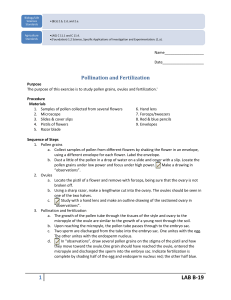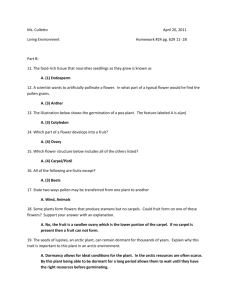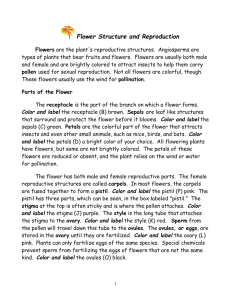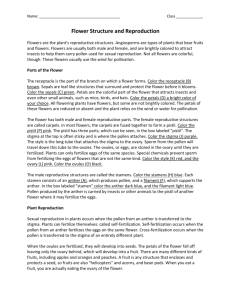Flowers and Flowering Plants
advertisement
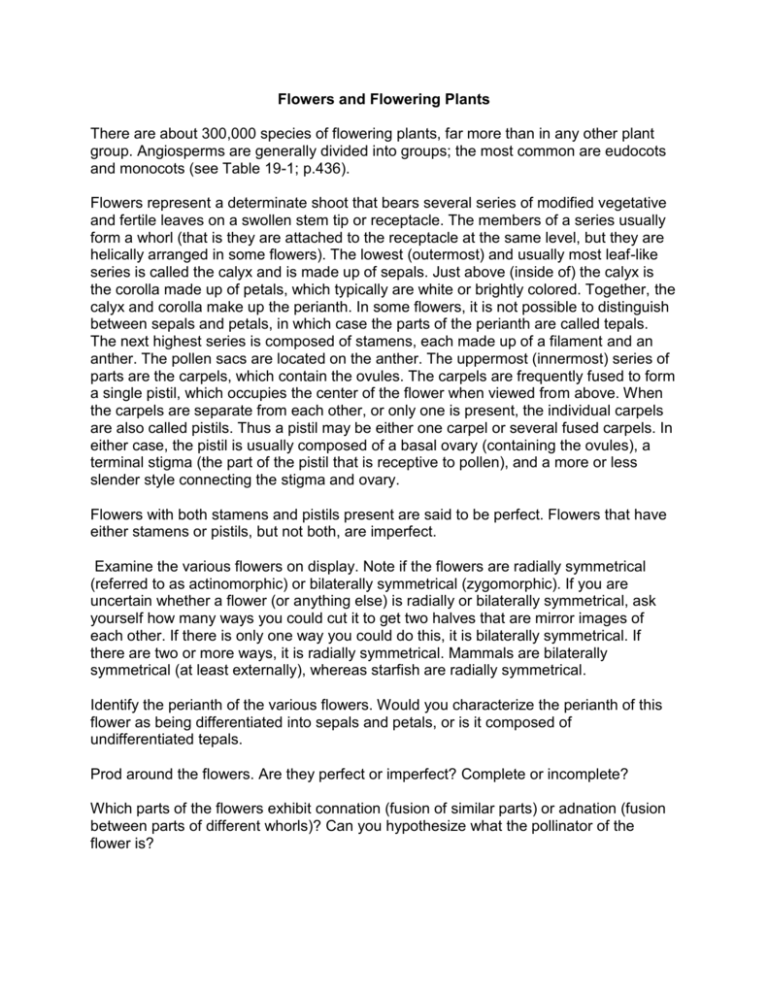
Flowers and Flowering Plants There are about 300,000 species of flowering plants, far more than in any other plant group. Angiosperms are generally divided into groups; the most common are eudocots and monocots (see Table 19-1; p.436). Flowers represent a determinate shoot that bears several series of modified vegetative and fertile leaves on a swollen stem tip or receptacle. The members of a series usually form a whorl (that is they are attached to the receptacle at the same level, but they are helically arranged in some flowers). The lowest (outermost) and usually most leaf-like series is called the calyx and is made up of sepals. Just above (inside of) the calyx is the corolla made up of petals, which typically are white or brightly colored. Together, the calyx and corolla make up the perianth. In some flowers, it is not possible to distinguish between sepals and petals, in which case the parts of the perianth are called tepals. The next highest series is composed of stamens, each made up of a filament and an anther. The pollen sacs are located on the anther. The uppermost (innermost) series of parts are the carpels, which contain the ovules. The carpels are frequently fused to form a single pistil, which occupies the center of the flower when viewed from above. When the carpels are separate from each other, or only one is present, the individual carpels are also called pistils. Thus a pistil may be either one carpel or several fused carpels. In either case, the pistil is usually composed of a basal ovary (containing the ovules), a terminal stigma (the part of the pistil that is receptive to pollen), and a more or less slender style connecting the stigma and ovary. Flowers with both stamens and pistils present are said to be perfect. Flowers that have either stamens or pistils, but not both, are imperfect. Examine the various flowers on display. Note if the flowers are radially symmetrical (referred to as actinomorphic) or bilaterally symmetrical (zygomorphic). If you are uncertain whether a flower (or anything else) is radially or bilaterally symmetrical, ask yourself how many ways you could cut it to get two halves that are mirror images of each other. If there is only one way you could do this, it is bilaterally symmetrical. If there are two or more ways, it is radially symmetrical. Mammals are bilaterally symmetrical (at least externally), whereas starfish are radially symmetrical. Identify the perianth of the various flowers. Would you characterize the perianth of this flower as being differentiated into sepals and petals, or is it composed of undifferentiated tepals. Prod around the flowers. Are they perfect or imperfect? Complete or incomplete? Which parts of the flowers exhibit connation (fusion of similar parts) or adnation (fusion between parts of different whorls)? Can you hypothesize what the pollinator of the flower is? Fruits and Fruit Development Fruits develop from the ovary of the flower and may include additional accessory structures that derive from other parts of the flower or inflorescence. To understand fruits clearly, one must follow their development from flowers. In this laboratory you will examine fruit structure and will use an identification key to learn to distinguish various fruit types Fruits are classified by several groups of characters. To identify any fruit, you will need to classify its various characteristics. For example, is the fruit dry or fleshy, dehiscent (opens at maturity to shed seeds) or indehiscent (does not open at maturity), or a simple fruit (made up of one pistil of one flower), an aggregate fruit (made up of several separate pistils of a single flower), or a multiple fruit (made up of several flowers)? * Examine the fruits on display. Use the first key to determine whether each fruit is simple, multiple, or aggregate. Then use the second key to identify the fruit type more specifically (e.g., achene, capsule, berry). For example, you may see a multiple fruit composed of berries or an aggregate fruit composed of follicles. In addition, some may also be accessory fruits; that is, part of the tissue forming the fruit is derived from something other than the ovary wall, such as the receptacle. In the future, you may be shown a fruit you have never seen and be asked to identify the fruit type without the aid of the keys. You may also be asked whether a particular fruit is dehiscent or indehiscent; simple, multiple, or aggregate; or accessory or not. SKIPPED Exercise B. Angiosperm Life Cycle The angiosperm life cycle is similar to that of other seed plants, but the gametophytes are more reduced. The mature megagametophyte usually consists of only seven cells and the microgametophyte of only three. Angiosperms differ from most other seed plants in having double fertilization involving two sperm nuclei. In the double fertilization of angiosperms, one sperm nucleus unites with the egg to yield the zygote, while the other unites with the two nuclei in the central cell of the megagametophyte to yield the first cell of a nutritive tissue called endosperm (which feeds the embryo during seed development). * Examine a prepared slide of several sections of a Lilium ovule (megasporocyte stage). Ovules are visible in each of the three locules (chambers) of the ovary. Each ovule consists of a nucellus (megasporangium), which contains a megaspore mother cell (= megasporocyte), and is surrounded by two integuments. The ovule is attached to the wall of the ovary by a stalk called the funiculus. *Identify the locules, ovules, integuments, nucellus, megaspore mother cell, and funiculus. How many ovules can you see in each locule? What is the ploidy level of each of these structures? What process will occur in the megaspore mother cell subsequent to the stage shown in this slide? * Examine a prepared slide of a Lilium ovule containing a four-nucleate megagametophyte. The megagametophyte of an angiosperm is called an embryo sac (not to be confused with an embryo!). * Examine a prepared slide of a Lilium ovule with a mature embryo sac. Inside the nucellus is the mature embryo sac consisting of seven cells and eight nuclei (see photograph and drawing on p. 507). There are three small cells at each end of the embryo sac and a large, binucleate cell in the center. You may not be able to see all of the cells and nuclei if the slide is not a perfect median section. The egg cell is the middle cell of the three small ones at the end of the embryo sac nearest to the micropyle. The large central cell contains two nuclei called polar nuclei, which play an important role in fertilization (see below). Identify the integuments, nucellus, ovule, funiculus, and embryo sac. Are the egg and polar nuclei visible? Part 2. Young anther and pollen grains of Lilium *Examine a prepared slide of a Lilium anther showing tetrads of microspores following meiosis (compare to Fig. 21-14; 504. This is a cross section through an immature anther). There are four pollen sacs (microsporangia) per anther. In the center of each pollen sac are tetrads of microspores. A tetrad is simply a group of four. Why are the microspores in groups of four? The tetrads are surrounded by the tapetum, a nutritive tissue derived from the innermost layer of the pollen sac. Identify the pollen sacs, microspores, and tapetal remnants. * Examine a prepared slide of Lilium mature anthers (see p. 504, right). The walls between the pollen sacs have broken down, and now there are two large pollencontaining chambers. The microspores have given rise to pollen grains (immature male gametophytes). Each pollen grain consists of two cells: a large tube cell whose nucleus contains a conspicuous nucleolus, and a smaller, lens-shaped generative cell, which is often hard to discern. The generative cell will eventually divide mitotically to produce the two sperm cells. Identify the pollen grains. Find the tube cell and generative cell. Demo – if available, examine some pollen grains that have been placed in a sugar solution. The sugar stimulates the pollen grains to germinate and produce a pollen tube. In nature, when the pollen lands on the stigma, the pollen tube begins to grow down the style. The two sperm cells produced form the generative cell travel down the tube to reach the embryo sac (see Fig. 21-19; p. 508). One sperm unites with the egg to yield the zygote. The other unites with the two polar nuclei of the central cell to yield the primary endosperm nucleus. This process is called double fertilization. The primary endosperm nucleus subsequently develops into the endosperm, which nourishes the developing embryo inside the seed. What is the ploidy level of the endosperm? * Examine a prepared slide of pollen tubes. Identify the tube cell and sperm cells. * Examine the prepared slide of a Lilium ovule showing double fertilization, and compare it to Fig. 18-20 (p. 509). Had to skip in 08 – no flowers available! Exercise A. Fruit Development * Observe living bean and pea flowers. Describe the flower in terms of symmetry, connation, adnation, and ovary position. Is it perfect or imperfect? Find the keel (lower), wings (side), and standard (upper) petals. This type of flower is characteristic of members of the bean family (beans, peas, and individual clover flowers). * On a bean plant with developing fruits, identify the sepals, style, and stigma of the old flower. * Dissect one of the bean fruits provided. Identify the ovary and the funiculus that attaches each ovule/seed to the ovary wall. This is a simple fruit (defined as a fruit that develops from a single pistil). You will later see fruits that develop from more than one pistil. * Carefully remove the seed coat form one of the ovules/seeds. Separate the ovule/seed into two halves (cotyledons). Is there an embryo present? Are these ovules or seeds?


